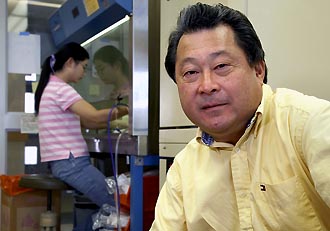Muneoka Leads Limb Regeneration Research
Could the salamander's natural ability to grow back severed appendages lead to a scientific breakthrough for humans who have lost limbs?

As biology professor Ken Muneoka and his research team try to understand the genetics behind limb regeneration in salamanders, they hope to make progress for tissue regeneration in humans. (Photo by Rick Olivier)
With the help of a $6.25 million U.S. Department of Defense grant, Tulane University professor Ken Muneoka, who holds the John L. and Mary Wright Ebaugh Chair in Science and Engineering, will lead a team of researchers from the University of Californiaâ“Irvine and the University of Kentucky to identify the genes that trigger regeneration in the axolotl, a Mexican salamander.
The researchers then will attempt to determine how the same genes are regulated in response to injuries in mice. Because of their similar genetic characteristics, mice serve as a model for humans.
"The hope is that once the genetic signals for regeneration are identified, therapies can be developed to enhance the regenerative response in humans," says Muneoka, a professor in the Department of Cell and Molecular Biology.
Regeneration of tissue in humans is Muneoka's long-term goal. Like his colleagues, he has conducted research in this area for many decades.
The shorter-term goal is to modify the body's natural healing process to transition from a scar-forming response to the initiation of a regenerative response. Muneoka says this might involve cell-based therapies with regeneration-promoting cells, and/or factor-based therapies, such as providing a specific growth factor, to initiate and/or sustain the regenerative response.
While the salamander is the only animal capable of regenerating lost appendages, a child can grow back the tip of a severed finger, and, even in adults, bone, muscle, cartilage and skin can independently undergo a healing and regeneration response.
"What's missing is a way to coordinate these events so complex structures can be restored," Muneoka says. "By establishing a comprehensive database that identifies all the genes involved in regenerating a salamander limb, we will essentially create a genetic blueprint of how to do the same in humans."
The grant that will fund Muneoka and his colleagues&##39; research is the result of a competition that the Army Research Office, the Office of Naval Research and the Air Force Office of Scientific Research conducted under the Department of Defense's Multidisciplinary University Research Initiative Program.
Through the competition, 69 academic institutions were awarded $260 million over the next five years to perform multidisciplinary basic research.
